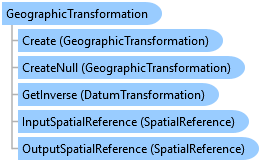
GeographicTransformation Class
In This Topic
A geographic transformation is used when
projecting geometries between two different geographic coordinate systems. A geographic
transformation converts everything that needs to be changed including the units,
prime meridian, and the ellipsoid. Every transformation is defined in a particular forward
direction, say from GCS A to GCS B, but all are reversible. For example, a geographic
transformation may be defined to convert from NAD27 to WGS84. If you are projecting from
WGS84 to NAD27, you can use the reversed form of the transformation.
Object Model

Syntax
public sealed class GeographicTransformation : DatumTransformation
Public NotInheritable Class GeographicTransformation Inherits DatumTransformation
Example
Determine Transformations
// methods need to run on the MCT ArcGIS.Desktop.Framework.Threading.Tasks.QueuedTask.Run(() => { // // find the first transformation used between spatial references 4267 and 4326 // SpatialReference sr4267 = SpatialReferenceBuilder.CreateSpatialReference(4267); SpatialReference sr4326 = SpatialReferences.WGS84; List<ProjectionTransformation> transformations = ProjectionTransformation.FindTransformations(sr4267, sr4326); // transformations.Count = 1 ProjectionTransformation projTrans = transformations[0]; CompositeGeographicTransformation compositeGT = projTrans.Transformation as CompositeGeographicTransformation; GeographicTransformation gt = compositeGT[0]; // gt.Wkid = 15851 // gt.Name = "NAD_1927_To_WGS_1984_79_CONUS" // gt.IsForward = true // // find the first five transformation used between spatial references 4267 and 4326 // transformations = ProjectionTransformation.FindTransformations( sr4267, sr4326, numResults: 5); // transformations.Count = 5 projTrans = transformations[0]; compositeGT = projTrans.Transformation as CompositeGeographicTransformation; // compositeGT.Count = 1 // compositeGT[0].Wkid = 15851 // compositeGT[0].Name = "NAD_1927_To_WGS_1984_79_CONUS" // compositeGT[0].IsForward = true projTrans = transformations[1]; compositeGT = projTrans.Transformation as CompositeGeographicTransformation; // compositeGT.Count = 1 // compositeGT[0].Wkid = 1173 // compositeGT[0].Name = "NAD_1927_To_WGS_1984_4" // compositeGT[0].IsForward = true projTrans = transformations[2]; compositeGT = projTrans.Transformation as CompositeGeographicTransformation; // compositeGT.Count = 1 // compositeGT[0].Wkid = 1172 // compositeGT[0].Name = "NAD_1927_To_WGS_1984_3" // compositeGT[0].IsForward = true projTrans = transformations[3]; compositeGT = projTrans.Transformation as CompositeGeographicTransformation; // compositeGT.Count = 2 // compositeGT[0].Wkid = 1241 // compositeGT[0].Name = "NAD_1927_To_NAD_1983_NADCON" // compositeGT[0].IsForward = true // compositeGT[1].Wkid = 108190 // compositeGT[1].Name = "WGS_1984_(ITRF00)_To_NAD_1983" // compositeGT[1].IsForward = false projTrans = transformations[4]; compositeGT = projTrans.Transformation as CompositeGeographicTransformation; // compositeGT.Count = 2 // compositeGT[0].Wkid = 1241 // compositeGT[0].Name = "NAD_1927_To_NAD_1983_NADCON" // compositeGT[0].IsForward = true // compositeGT[1].Wkid = 1515 // compositeGT[1].Name = "NAD_1983_To_WGS_1984_5" // compositeGT[1].IsForward = true // // find the first transformation used between spatial // references 4267 and 4326 within Alaska // // Alaska Envelope envelope = EnvelopeBuilderEx.CreateEnvelope(-161, 61, -145, 69); transformations = ProjectionTransformation.FindTransformations( sr4267, sr4326, envelope); // transformations.Count = 1 projTrans = transformations[0]; compositeGT = projTrans.Transformation as CompositeGeographicTransformation; // compositeGT.Count = 2 // compositeGT[0].Wkid = 1243 // compositeGT[0].Name = "NAD_1927_To_NAD_1983_Alaska" // compositeGT[0].IsForward = true // compositeGT[1].Wkid = 108190 // compositeGT[1].Name = "WGS_1984_(ITRF00)_To_NAD_1983" // compositeGT[1].IsForward = false // // find the first geographic transformation used between two spatial references with VCS (use vertical = false) // SpatialReference inSR = SpatialReferenceBuilder.CreateSpatialReference(4269, 115702); SpatialReference outSR = SpatialReferenceBuilder.CreateSpatialReference(4326, 3855); // Even though each spatial reference has a VCS, // vertical = false should return geographic transformations. transformations = ProjectionTransformation.FindTransformations(inSR, outSR); // transformations.Count = 1 projTrans = transformations[0]; compositeGT = projTrans.Transformation as CompositeGeographicTransformation; // compositeGT.Count = 1 // compositeGT[0].Wkid = 108190 // compositeGT[0].Name = ""WGS_1984_(ITRF00)_To_NAD_1983" // compositeGT[0].IsForward = false // // find the first vertical transformation used between two spatial references with VCS (use vertical = true) // transformations = ProjectionTransformation.FindTransformations( inSR, outSR, vertical: true); // transformations.Count = 1 projTrans = transformations[0]; CompositeHVDatumTransformation compositeHV = projTrans.Transformation as CompositeHVDatumTransformation; // compositeHV.Count = 2 // compositeHV[0].Wkid = 1188 // compositeHV[0].Name = "NAD_1983_To_WGS_1984_1" // compositeHV[0].IsForward = true // compositeHV[1].Wkid = 110019 // compositeHV[1].Name = "WGS_1984_To_WGS_1984_EGM2008_2.5x2.5_Height" // compositeHV[1].IsForward = true });
Inheritance Hierarchy
System.Object
ArcGIS.Core.Geometry.DatumTransformation
ArcGIS.Core.Geometry.GeographicTransformation
Requirements
Target Platforms: Windows 11, Windows 10
ArcGIS Pro version: 3 or higher.
See Also